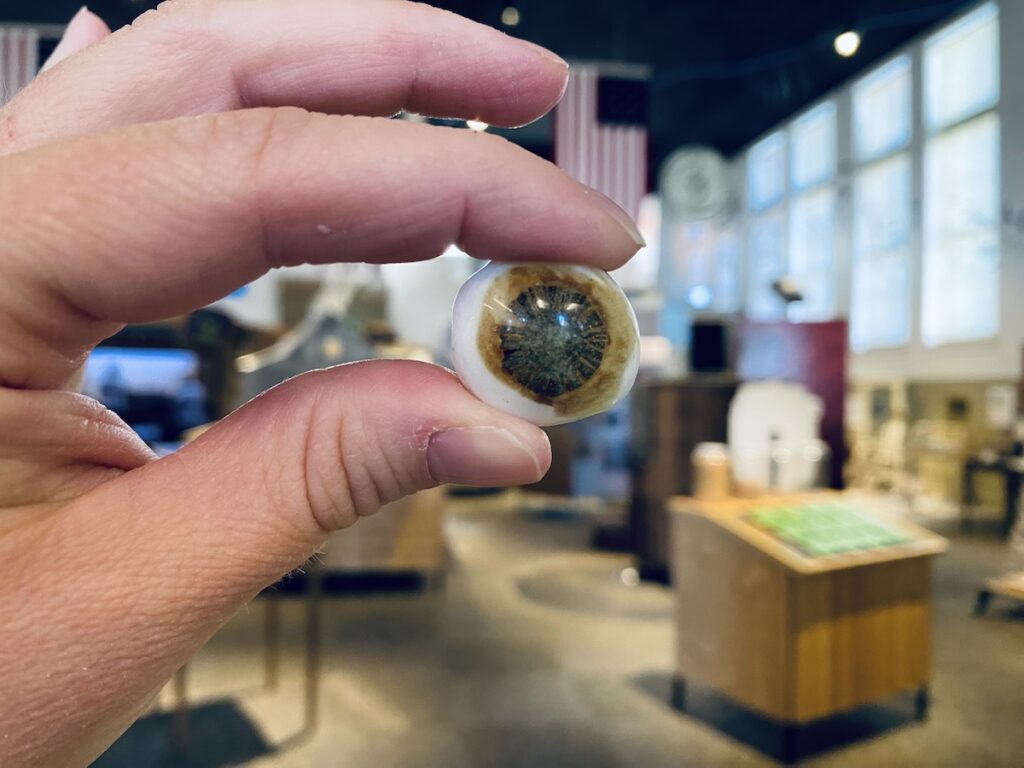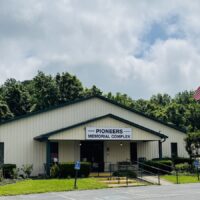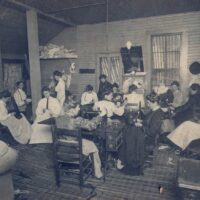This month’s artifact is by far the smallest one that I’ve featured. It is one of the smallest artifacts in the museum’s collection — and easily one of the most visually compelling. It measures only 1 inch wide at its widest point. It’s less than an inch tall and just a half-inch deep.
Its shape is hard to identify; it is somewhat rounded on one side and slightly convex on another. It is smooth and lightweight. It is likely made of an acrylic plastic, and although time has discolored the design, it has been artfully painted on its main face.
This month, we take a look at a glass eye.

This artifact has intrigued me since I first discovered that it existed. Never did I imagine that this eye would be staring back at me when I opened its tiny storage box. I find it both fascinating and a little creepy. I can’t believe it has taken me this long to dig into its story!
When we renovated the Pennyroyal Area Museum, I insisted that we find a place to display it. The world needs to see this glass eye!
While I don’t believe that our glass eye is actually made of glass, these artificial eye replacements had been made of glass and other precious materials in the past. According to a little basic research, the earliest known example of an ocular prosthesis dates back to 2900-2800 B.C. and was discovered in a tomb in Iran. Evidence of prosthetic eyes has been found in early Hebrew, Roman and Egyptian cultures, and many note the use of both clay and gold to form the optical orb.
The Venetians mastered the art of eye-making and introduced the use of glass. Germany became the center of the craft during the 18th and 19th centuries due to their superior glass-blowing techniques. Apparently, the US began making glass eyes out of acrylic plastic when German goods became inaccessible during World War II. I think our eye comes from this era.
The prosthetic itself is used when a person’s natural eye is damaged and removed. The prosthesis is fitted over an implant by an ocularist. Ocularists are not medical doctors but are rather specially trained professionals who fit, create, shape and paint glass eyes.
So, how did the museum come to have a glass eye in our collection?
The good, and possibly disappointing, news is that I don’t think that our glass eye belonged to someone who needed it for its intended purpose. Based on its donor information, I think it was simply a floor model.
This artifact came to us as part of the estate of Dr. Bertha Beazley. Born in 1919 in Huntington, West Virginia, Beazley was the daughter of Dr. Charles and Corda Drake. Her father was a dentist. Bertha attended Marshall College in her hometown before enrolling in the University of Louisville School of Dentistry. It was here that she met Hugh Carson Beazley, a Hopkinsville native, who was also studying dentistry. The two married in December 1942 while he was stationed at Fort Sam Houston in Texas where he was serving with the Army’s Dental Corps.
It should be noted that Bertha was one of very few women in dental school in the 1940s. The School of Dentistry at UofL graduated its first female student Aimee L. Jones in 1901. Shortly thereafter, the school refused admission to women altogether. By the 1940s, women outnumbered men on campus thanks to WWII, but the dental school remained predominantly male. Bertha was breaking boundaries!
The two opened their joint dentist office on Walnut Street in Hopkinsville in 1943 and practiced here for more than 40 years. Both were members of the American and Kentucky dental associations, and both served as president of the West Central Dental Society. Bertha was an active member of the Hopkinsville Business & Professional Women’s Club, and she and her husband were involved with Boy and Girl Scouts, the Pennyrile Players, and the Community Concert Association. Dr. Hugh played violin and clarinet, and both were members of the chancel choir at First United Methodist Church. The couple had four daughters. Dr. Hugh died in 1991, and Dr. Bertha passed away in 1994.
To my knowledge, neither dentist had the personal need for a glass eye.
And yet, this prosthetic is one of close to one hundred artifacts donated by their daughters from Dr. Bertha Beazley’s estate.
The answer is simple.
The glass eye most likely belonged to Dr. Hugh Coleman Beazley, father (and father-in-law) of the aforementioned Drs. Beazley. Born in 1876 in LaFayette, Dr. H.C. Beazley graduated from Vanderbilt University with his M.D. and received additional training at New York City Polyclinic. He specialized in eye-ear-nose-and-throat illnesses.
The glass eye belonged to Dr. Hugh Coleman Beazley. My best guess is that this piece was a sample that Dr. Beazley could use to show patients their options for prosthetic replacements.
Dr. Beazley was quite the accomplished man. Not only did he hold his M.D. from Vanderbilt, but he also earned a Bachelors of Arts degree from South Kentucky College and a law degree from Cumberland University in Lebanon, Tennessee. Initially, he opened a practice in Bowling Green and established his medical office in Hopkinsville a few years later. He maintained an office upstairs above the Kress store on Main Street just south of 8th Street for many years. Eventually, he would close his downtown office, but he continued to see patients in his home on Walnut Street. He and his wife Carrie had one son – Hugh Coleman, the future dentist. This Dr. Beazley died in 1961.
But there is one additional curiosity that this glass eye brings to light. While Dr. H.C. Beazley practiced medicine in Bowling Green, he boarded in a home with a roommate. This roommate was also from Christian County. He had moved to Bowling Green to open a photography studio. The two became such good friends that Hugh served as a groomsman in the young photographer’s wedding, and their wives became dear, lifelong friends.
That young photographer was Edgar Cayce. While living with Beazley in Bowling Green, Edgar experimented a great deal with his psychic abilities, and Beazley would have had a front row seat. The young doctor even provided guidance when Edgar gave readings with confounding treatment recommendations for someone in ill health. Their friendship and connection at this pivotal point in Edgar Cayce’s life is documented in Cayce’s top two biographies “There is a River” and “Edgar Cayce: An American Prophet.”
Even the smallest of artifacts can tell so many stories and connect us to our community’s past.
Alissa Keller is the executive director of the Museums of Historic Hopkinsville-Christian County. She’s a graduate of Centre College with degrees in history and English and of Clemson University/College of Charleston with a master’s degree in historic preservation. She serves on the Kentucky Historical Society and the Kentucky Museum and Heritage Alliance boards.





